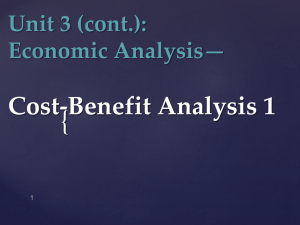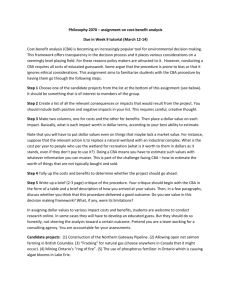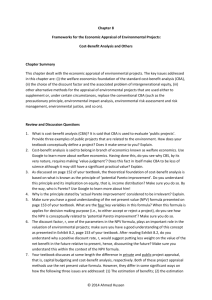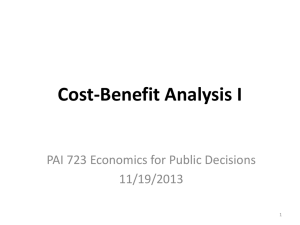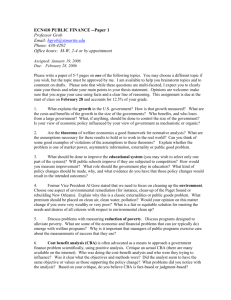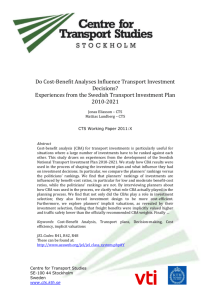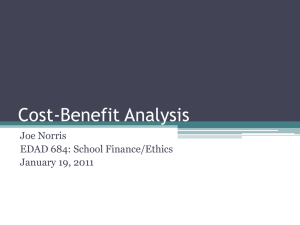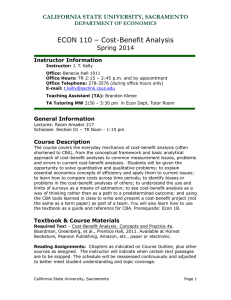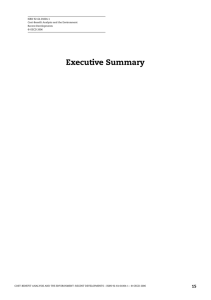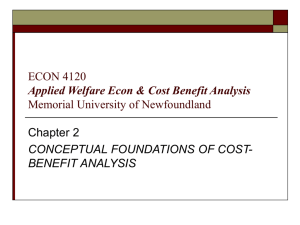Cost-Benefit Analysis (CBA)
advertisement
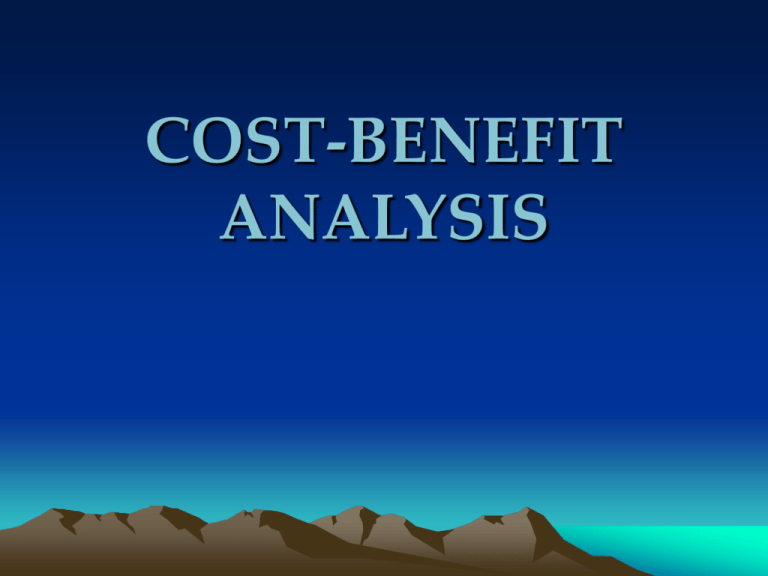
COST-BENEFIT ANALYSIS “It is best to think of the cost-benefit approach as a way of organizing thought rather than as a substitute for it.” — Michael Drummond Cost-Benefit Analysis Cost-benefit analysis (CBA) is the implicit or explicit assessment of the benefits and costs (i.e., pros and cons, advantages and disadvantages) associated with a particular choice. Benefits and costs may be monetary (pecuniary) or non-monetary (non-pecuniary, “psychic”). For private decisions, such as taking martial arts classes or going to a movie on Saturday night, we are often not aware of any internal process of consideration of costs and benefits, but behave as though we do. An individual will choose an action if: Benefits (B) > Costs (C) or Net Benefits (NB) = B - C > 0. Joan will smoke if B > C. For Joan, B’s are: taste/oral satisfaction, relaxation, diet control, and improved work performance. C’s are: expense, health consequences, value of time spent, discomfort/inconvenience of “smoking-allowed areas”, and disapproval of others. For the continuous choice of how many cigarettes to smoke, Joan will smoke the number of cigarettes which yield the greatest net benefits. CBA is most commonly used for public decisions– policy proposals, programs, and projects, e.g., dams, bridges, traffic circles, riverfront parks, libraries, drunk driving laws, and anything else the government might fund. CBA can be used to rank alternative projects as well as evaluating the social value of one particular project. Even if CBA is not explicit, any decision, public or private, reveals a cost-benefit calculus consistent with the observed choice. Example: Ashenfelter, Orley and Michael Greenstone, “Using Mandated Speed Limits to Measure the Value of a Statistical Life,” National Bureau of Economic Research Working Paper w9094, August 2002 (http:www.nber.org/papers/w9094) Raising the maximum speed limit from 55 to 65 increased travel speed by about 2 mph (people often exceed posted speed) saving 45 million hours travel time per year, and inducing about 360 deaths per year (125,000 hours of life). Our collective decision to drive faster infers that 45 million hours of travel time is worth more that 360 deaths. Our decisions lead to changes in benefits and costs regardless of whether we make them explicit. Example: Knee Injury: Getzen, Thomas E., Health Economics, Second Edition New York: Wiley and Sons, 2004. Playing soccer, you injure your knee. Do you go to the emergency room (ER)? CBA usually takes the form of an explicit and formal presentation of a balance sheet, i.e., is it worth taking 3 hours and possibly $80 to go to the ER so that a doctor can alleviate pain and check for serious damage? Outlining benefits and costs assists rational decisionmaking. 1. Enumerate benefits and costs. (Handout, Table 3.1) 2. Quantify each benefit and cost as accurately as possible (usually expressed in dollars), given the information at hand. (Handout, Table 3.2) Previously set appointment for Thursday means the proper comparison is treatment today vs. treatment Thursday (not treatment vs. no treatment). Time lost - opportunity cost of time commonly measured by the wage, e.g., $7/hour. Value of athletic image - what you are willing to pay to preserve your image, e.g., $40 for crutches Value of stopping pain with certainty -the highest amount you would pay to stop the pain for 10 days, e.g., by buying painkillers. Expected value of stopping pain by going to the ER = probability that the ER visit will result in stopping the pain times the value of stopping the pain with certainty. Expected Value When values of costs or benefits are not known with certainty, but are known with probability, expected values are used. Expected value of a benefit is: E(B) = i prob(B=bi) bi where prob(B=bi) is the probability that the benefit is worth $ bi . Knee Injury Cost of visit to ER=$50, $100 or more; expected value = 80 $80 is a weighted average, where the weights are the probabilities that alternative cost values will occur. That is, if $50 will occur with probability 0.6, $100 will occur with probability 0.2, and $150 will occur with probability 0.2, then E(C)=.6 (50)+.2 (100)+.2 (150)= 80 Example: Mauskopf, J.A. et. al, “Economic Impact of Treatment of HIV-Positive Pregnant Women and their Newborns with Zidovudine: Implications for HIV Screening,” JAMA 276: 2, 132-8, July 10, 1996. Probability of maternal-to-fetal transmission when the mother is HIV-positive No Treatment = 25.5% With Zidovudine Treatment = 8.3% Lifetime cost of treatment of an infected child from birth = $98,915 Expected value of cost of a lifetime pediatric HIV infection = probability of transmission lifetime treatment costs No Treatment = .255 98,915 = $25,223 With Treatment = .083 98,915 = $ 8,210 Expected benefits of treatment = Expected costs averted by treatment = 25,223 - 8,210 = $17,013 Cost of Zidovudine treatment = $1,045 Expected Net Benefits = 17,013 - 1,045 = $15,968 per HIV-positive pregnant woman If medical expenses are paid privately, the woman will opt for the treatment. If the child will be on public assistance for medical care (e.g., Medicaid–OHP), it benefits society to treat the mother with Zidovudine. Theory of Cost-Benefit Analysis Public Policy Objective: Choose the level of output of a good or service to maximize net social benefits (NSB) NSB = TSB – TSC where TSB = total social benefits TSC = total social costs Marginal Social Benefit (MSB) = additional social benefits from one more unit of output Marginal Social Cost (MSC) = additional social costs of producing one more unit of output MSB = d TSB/d Q MSC = d TSC/d Q Q = quantity of a publicly provided good or service NSB are max when MSB = MSC Social Decision Rule: Choose Q for which MSB = MSC Present Value Future, as well as present, benefits and costs must be included in the analysis. But costs and benefits that accrue in the future are worth less than costs and benefits today. Economic agents and society as a whole will maximize the present value of expected net benefits. Costs and benefits may occur over different periods of time, e.g., costs for a dam built today may be spent primarily during the initial period of the project, but benefits will accrue over the lifetime of the dam. To account for all costs and benefits in the same units across time periods, we calculate the present value of net benefits: PV(NB) = t NB/(1+r)t Present Value Worksheet $100 invested today at an annual interest rate (r) of 4% will be worth $104 in 1 year. Present value (PV) of $104 next year when r=.04 is $100. That is, $104 tomorrow is worth $100 today. PV = F/(1 + r), where F is a fixed sum of money to be received next year. Discount Rate What value of r should be used? r = rate of discount of future consumption or rate of time preference The higher the social discount rate, the higher the social value of consumption today relative to consumption tomorrow. Conventional to use 3-5% or the T-Bill interest rate since it represents the cost of borrowing at virtually no risk. Results can be sensitive to the discount rate chosen. Researchers often conduct a sensitivity analysis to see how sensitive the results are to changes in assumptions about the discount rate, costs, and benefits. Value of life Does society view life as infinitely valuable? Many public programs and projects involve the prevention of loss of life: dams, maintaining roads, traffic signs, provision of health care, employment of firefighters, etc. How do economists value a life saved (death averted) in the cost-benefit calculus? 1. Human Capital Approach Value of life = present value of lifetime earnings (= lifetime productivity in competition) •represents productivity gains from extending life (benefit side) or productivity losses from early death (cost side) • •for society as a whole, represents a loss in national output due to mortality Method often used in court cases, e.g., court awards the family of a man who dies at 35 in a car accident the amount of his expected PV of lifetime earnings = $650,000 Problems with human capital approach: •People who are not working for pay (e.g., homemakers, students, retirees) are valued at 0! (Even for the employed, time away from the job is valued at 0.) •Implies that people with higher wages have higher social value. •Does not account for labor market imperfections, e.g., discrimination. 2. Willingness-to-pay (WTP) Approach Value of life is estimated from the amounts that people are WTP to reduce the probability of dying. Suppose the cost of a safety device (e.g., smoke detectors, seat belts, radon gas detectors) which reduces the probability of death by 1 in 10,000 is $100, and people are WTP the $100. Recall net benefits are maximized when marginal benefit (MB) = marginal cost (MC). Benefit of 1 more safety device (MB) = (change in probability of dying) (value of life) Cost of 1 more safety device = MC Assuming people are maximizing NB, MB = MC MC = (change in probability of dying) (value of life) Value of life = MC/(change in probability of dying) = 100 (1/10,000) Value of life = $1 million • • • • • Advantages. •Measures total value of life (not just labor market value) •Includes foregone earnings and nonmarket value of life Disadvantages. •Estimates vary widely •Price may be less than true WTP, value will be understated
